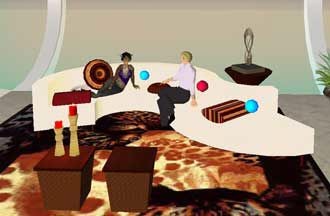| Aaron Delwiche, right, interviews SA-based Adri Saarien/Adrienne Haik, who helped plan the Second Life Coulton concert. |
I was buried waist-deep in a stack of un-graded papers when my computer chirped with an unusual invitation from a former student. He told me that singer-songwriter Jonathan Coulton was headlining a concert in Second Life to promote the magazine PopSci and the nonprofit group Creative Commons.
Intrigued by the prospect of watching live music in a virtual world, I raced home to join the fun. By the time I teleported into the venue, it was packed with people from all corners of the globe. Most were seated, but others were dancing and some were sitting on the rafters.
As with any new technology, there were a handful of technical difficulties. The sound dropped out for some guests halfway through the show, but the organizers immediately solved the problem by mirroring the audio on third-party websites. At one point, the concert hall rebooted, and we were all forced to teleport out of the room for a few moments. But the enthusiastic crowd took these minor problems in stride.
So what is it like to watch a concert in a virtual world? As you might expect, audience members are distanced from the performers. Multiple layers of human communication (e.g. nonverbals, smell, and posture) are erased by the homogenizing embrace of online avatars. Throughout the show I took brief breaks from the computer to reheat leftovers, play with my cat, and open a bottle of wine — causing me to wonder what everyone else in the venue was up to in the real world.
Nonetheless, online concerts can bring users closer to the action. At real-world concerts, it is easy to end up trapped in a clump of sweaty bodies near the center of the crowd. In some cases, the thrill of watching live shows stems from the adrenaline rush that one experiences when trying not to be trampled. In virtual words, this is not an issue. Audience members can sit, stand, or dance in one location while moving a perspective camera throughout the environment. Even when seated behind a nine-foot tall, tuxedo-clad panther with flames shooting out of his skull, the player is able to see the action on stage.
However, after a few minutes of camera adjustment, it becomes clear that the musicians are not really the main event. The music is important, but the broader social context is far more exciting. Audience members are not just listening to music; they are listening to music while surrounded by dozens of creative and quirky minds. They are part of a community.
The show’s most memorable moment occurred when Coulton launched into a brilliant song about a zombified office worker who sings a memo to a former colleague who has not yet succumbed to the zombie invasion. When he launched into “Re: Your Brains,” audience members leapt from their seats, rushed the stage, and transformed their avatars into zombies.
I would give anything to see something like that happen when Wilco performs at Sunset Station next month.
By all measures, the event was a smashing success. Jonathan Coulton gained new fans, PopSci established itself as a vital force in digital culture, and Creative Commons demonstrated the viability of its approach to intellectual property.
Of course, this is not the first example of effective promotion in a virtual world. At least once a week, traditional media outlets report on similar stories. There have been fashion shows in There and Second Life, Kurt Vonnegut donned a convincing avatar to meet with readers, and Suzanne Vega gave a live concert. Governor Mark Warner teleported into Second Life earlier this month to deliver something that sounded suspiciously like a campaign speech. Even MTV is getting in on the act, launching a Laguna Beach experience connected to the virtual world There.com. During the past year, a handful of creative agencies such as The Electric Sheep Company (New York) and Millions of Us (Boston) have established themselves as virtual-world experts. Business is booming.
A few days after the show, I interviewed Adrienne Haik (aka Adri Saarinen), the San Antonio resident who planned media strategy and public relations for the Coulton event. Since she lives more than 30 minutes away, we met up in her gameworld office to discuss the future of media strategy in digital worlds.
“I think that virtual-world promotions are going to become more and more important to big companies as people turn off the TVs and turn on their computers,” she explained. “It’s proven that people are ‘blind’ to banner ads after only a few months of web surfing. Companies will have to get innovative to reach people.”
“And,” she added, “they’ll have to do it in an interactive way in 30 seconds or less.”
By now, readers might be feeling a bit of déjà vu. A new medium emerges on the fringes of popular culture. Bit by bit, businesses, politicians, and entertainers turn their attention to these new but dimly understood technologies. New creative agencies spring up to meet the growing demand. Does this all sound familiar?
I don’t know about you, but tonight I’m going to party like it’s 1994.
To catch the wave, you can set up a free account at There.Com and Secondlife.Com. Aaron Delwiche also writes about digital culture in his web log: Delwiche.livejournal.com.


